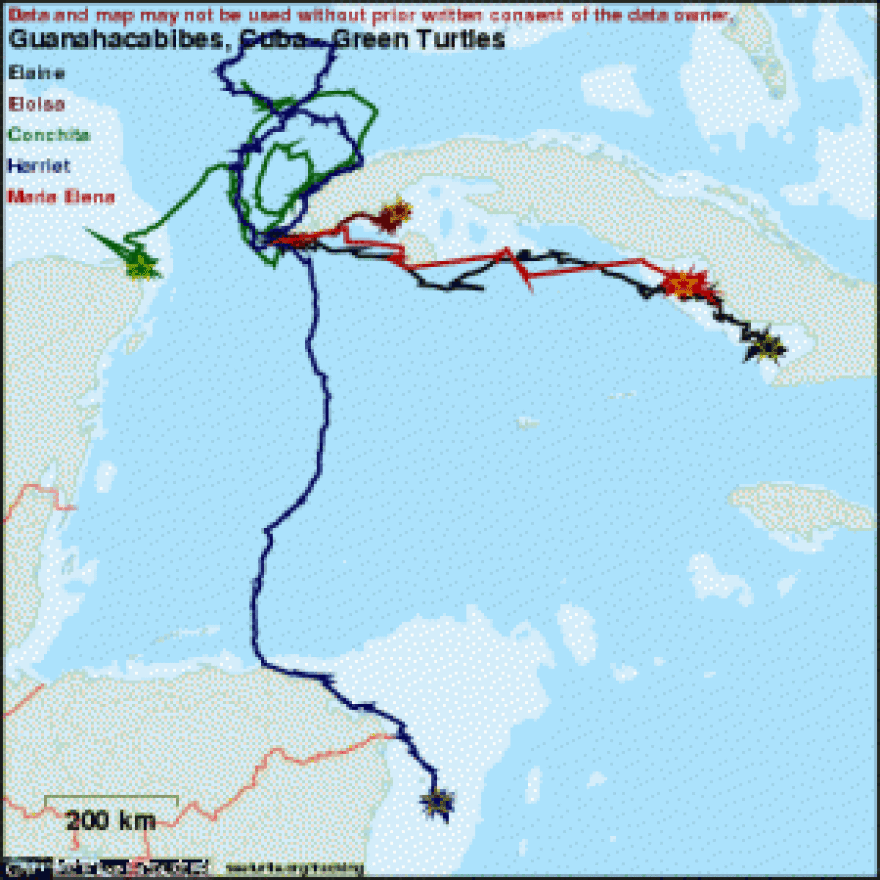A living fossil, sea turtles still nest up and down the busy and overbuilt South Florida coast and travel past our shores throughout the year. The various species of ocean roaming turtle are approximately 200-300 million years old but because they lay their eggs on our beaches, scientists are able to closely study the nomadic animals. For this reason, and with modern techniques such as satellite tagging, we can occasionally glimpse closely into their mysterious lives.

One of the finer specimens in the Miami Science Museum collection is a gigantic loggerhead shell. It is from a specimen estimated to be around 150 years old when it died! The shell is marked with a label that the object came from United States Customs, confiscated from someone trying to trade illegally in sea turtle paraphernalia. This is part of the reason the Museum’s collection of sea turtles, around 25 specimens, is so impressive. Even though bycatch – the accidental killing by commercial fisherman – is the greatest threat sea turtles, for many years they were hunted for their shells as luxury items, or to adorn jewelry. In some places, like in Cuba, the flippers, eggs, and head of sea turtles are still eaten by people holding on to age-old traditions, even though hunting them was banned years ago.

The Miami Science Museum’s very own Fernando Bretos is an expert on green turtles and he follows their movements and mating throughout the Caribbean, but mostly focusing on nesting and migrations between Florida and Cuba. Fernando is a Cuban-American who is trying to pick up the dialogue between Cuba and the United States through sea turtles. It is one of the few links in which exchange is allowed and encouraged, “maybe the only link even,” states Bretos, “and we must share information and resources to protect the animals.” Sea turtles become not just amazing animals to study and appreciate but are also fascinating to consider as a bridge between two politically embattled nations.

Fernando is attracted to sea turtles, not only because they are beautiful and need help, but also because he sees a link to himself. They are migratory; he has lived in Cuba, the U.S.A, and Australia. And the green turtle traveling through the Gulf Stream is particular to both his homeland of Cuba and home country of America. But he feels it’s important to understand what our changing definition of nature is. Fisheries biologist Jeremy Jackson suggests at the time of Columbus the green sea turtle population was approximately 660 million turtles. The Tortugas were named such because of this drastic overabundance, and some tales speak of sailors walking from shell to shell on over crowded beached. Indeed sea turtle was one of the primary food resource in the Caribbean. That is in contrast with the estimated 88,000 nesting females in existence today, as reported by the Sea Turtle Conservancy.
In a bittersweet moment, it is almost because of this overabundance of sea turtles in combination with the regulations now put against their trade, that the impressive collection of sea turtle specimens at the Miami Science Museum could be compiled. Through conservation and conversation they can come back, but the dialogue must remain. The collection also shows us how important sea turtles are locally in Miami. In fact, Florida’s beaches are the most important nesting site for loggerhead turtles on the planet! Even though it is 25 specimens, because the scientific community is trying to conserve the animals, a collection like the one the Miami Science Museum is actually quite impressive. It would be impossible to compile today, making it truly unique.

The image above is a satellite track from SeaTurtle.org of five green turtles that were tagged off the coast of Guanahacabibes UNESCO Biosphere Reserve in August 2012 immediately after laying eggs. Since their tagging, these five female turtles have begun their annual voyage to foraging and mating grounds. Two of the animals, one named Conchita, after Fernando’s mother, made a fast dash immediately for Florida. Conchita, whose track is labeled in green, suddenly made an abrupt turn and swam to Mexico’s Yucatan peninsula where she is now feeding on shallow sea grass beds.
It is critical to study the migratory movements of these enigmatic creatures. Without knowing where they feed, nest or travel, it is impossible to draft policies to protect them, particularly across international maritime borders.)
This story was reposted with permission from The Curious Vault, a bi-weekly online cabinet of curiosities featuring objects from the collection of the Miami Science Museum, presented by writer Nathaniel Sandler and Kevin Arrow, Art & Collections Manager. For more information, email karrow@miamisci.org.





